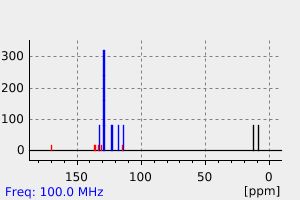N-benzoyl-2,3-dimethylindole | 53676-44-1
中文名称
——
中文别名
——
英文名称
N-benzoyl-2,3-dimethylindole
英文别名
1-benzoyl-2,3-dimethyl-1H-indole;(2,3-dimethylindol-1-yl)-phenylmethanone
CAS
53676-44-1
化学式
C17H15NO
mdl
——
分子量
249.312
InChiKey
CPHMUZKVQFIWHN-UHFFFAOYSA-N
BEILSTEIN
——
EINECS
——
-
物化性质
-
计算性质
-
ADMET
-
安全信息
-
SDS
-
制备方法与用途
-
上下游信息
-
文献信息
-
表征谱图
-
同类化合物
-
相关功能分类
-
相关结构分类
物化性质
-
熔点:98 °C
-
沸点:336.3±35.0 °C(Predicted)
-
密度:1.09±0.1 g/cm3(Predicted)
计算性质
-
辛醇/水分配系数(LogP):4.6
-
重原子数:19
-
可旋转键数:1
-
环数:3.0
-
sp3杂化的碳原子比例:0.12
-
拓扑面积:22
-
氢给体数:0
-
氢受体数:1
上下游信息
-
下游产品
中文名称 英文名称 CAS号 化学式 分子量 —— 1-benzoyl-2,3-bis(bromomethyl)indole 95712-50-8 C17H13Br2NO 407.104
反应信息
-
作为反应物:描述:N-benzoyl-2,3-dimethylindole 在 N-溴代丁二酰亚胺(NBS) 作用下, 以 四氯化碳 为溶剂, 以85%的产率得到1-benzoyl-2,3-bis(bromomethyl)indole参考文献:名称:吲哚-2,3-喹二甲烷的简单路线-咔唑的简便合成摘要:2,3-二甲基吲哚很容易转化为N-苯甲酰基-2,3-二溴甲基吲哚,后者在适当的亲二烯体存在下,在DMF中用碘化钠处理后,可提供咔唑衍生物。DOI:10.1016/s0040-4039(01)91303-6
-
作为产物:参考文献:名称:氟作为吲哚和色氨酸区域发散合成的无痕导向基团摘要:尽管有充足的证据表明高价 F-碘提供了独特的反应性,但机理研究远远落后。为了阐明此类 F 试剂的异常行为,我们对苯乙烯的化学发散转化进行了计算和实验研究。我们将螺环 F-环丙烷鉴定为 C, H-氟化和 C, H-胺化途径的常见中间体。这种关键化合物的命运取决于由 N 取代基控制的阳离子电荷离域程度。利用这种现象,可以进行多种不同的转化,即导致吲哚和色氨酸的区域发散合成。DOI:10.1021/jacs.8b08350
文献信息
-
Acylation, cyanoethylation and alkylation of methyl and phenyl indolylmagnesium salts: Influence of the substituents on the<i>c-</i>and<i>N</i>-reaction products作者:J. Gonzalo Rodríguez、Anahí UrrutiaDOI:10.1002/jhet.5570360119日期:1999.1influence of the substitution on indolylmagnesium salts in the reaction with benzoyl chlo ride, acrylonitrile and methyl iodide, giving the C- and N-derivatives, have been carried out. The yield in the C- and N-product depends upon the electronic character and position of the substituent (methyl or phenyl) on the indole ring and of the ethereal solvent as well as the concentration and molar ratio of the reagents
-
Eight‐Step Total Synthesis of Phalarine by Bioinspired Oxidative Coupling of Indole and Phenol作者:Lei Li、Kuo Yuan、Qianlan Jia、Yanxing JiaDOI:10.1002/anie.201900199日期:2019.4.23the benzofuro[3,2‐b]indoline framework could be obtained by PIDA‐mediated direct oxidative coupling of 2,3‐disubstituted‐indoles with phenols. Application of this chemistry allows for an eight‐step total synthesis of phalarine from commercially available tryptamine.
-
Synthesis of benzofuro[3,2-b]indolines via regioselective electrooxidative coupling of indoles and phenols作者:Keyuan Li、Yuan Wang、Lijun Chen、Lei Li、Yanxing JiaDOI:10.1016/j.tetlet.2020.152603日期:2021.1A green and regioselective electrooxidative coupling reaction between indoles and phenols for the synthesis of benzofuro[3,2-b]indolines was developed. A variety of benzofuro[3,2-b]indolines were prepared in moderate to excellent yields. A plausible mechanism was proposed.
-
Dearomative (3 + 2) Cycloadditions of Unprotected Indoles作者:Bram Ryckaert、Jan Hullaert、Kristof Van Hecke、Johan M. WinneDOI:10.1021/acs.orglett.2c01214日期:2022.6.17The (3 + 2) cycloaddition of various indoles with a dithioallyl cation affords dearomatized cyclopentannulated adducts, with complete control of regioselectivity and excellent chemo- and diastereoselectivity. The success of the reaction critically relies on the use of an excess of very strong Brønsted acid, which paradoxically prevents carbocationic side reactions. The reaction tolerates sensitive
-
224. Addition reactions of the indole nucleus作者:S. G. P. Plant、M. L. TomlinsonDOI:10.1039/jr9330000955日期:——
表征谱图
-
氢谱1HNMR
-
质谱MS
-
碳谱13CNMR
-
红外IR
-
拉曼Raman
-
峰位数据
-
峰位匹配
-
表征信息
同类化合物
(Z)-3-[[[2,4-二甲基-3-(乙氧羰基)吡咯-5-基]亚甲基]吲哚-2--2-
(S)-(-)-5'-苄氧基苯基卡维地洛
(R)-(+)-5'-苄氧基卡维地洛
(R)-卡洛芬
(N-(Boc)-2-吲哚基)二甲基硅烷醇钠
(E)-2-氰基-3-(5-(2-辛基-7-(4-(对甲苯基)-1,2,3,3a,4,8b-六氢环戊[b]吲哚-7-基)-2H-苯并[d][1,2,3]三唑-4-基)噻吩-2-基)丙烯酸
(4aS,9bR)-6-溴-2,3,4,4a,5,9b-六氢-1H-吡啶并[4,3-B]吲哚
(3Z)-3-(1H-咪唑-5-基亚甲基)-5-甲氧基-1H-吲哚-2-酮
(3Z)-3-[[[4-(二甲基氨基)苯基]亚甲基]-1H-吲哚-2-酮
(3R)-(-)-3-(1-甲基吲哚-3-基)丁酸甲酯
(3-氯-4,5-二氢-1,2-恶唑-5-基)(1,3-二氧代-1,3-二氢-2H-异吲哚-2-基)乙酸
齐多美辛
鸭脚树叶碱
鸭脚木碱,鸡骨常山碱
鲜麦得新糖
高氯酸1,1’-二(十六烷基)-3,3,3’,3’-四甲基吲哚碳菁
马鲁司特
马鞭草(VERBENAOFFICINALIS)提取物
马来酸阿洛司琼
马来酸替加色罗
顺式-ent-他达拉非
顺式-1,3,4,4a,5,9b-六氢-2H-吡啶并[4,3-b]吲哚-2-甲酸乙酯
顺式-(+-)-3,4-二氢-8-氯-4'-甲基-4-(甲基氨基)-螺(苯并(cd)吲哚-5(1H),2'(5'H)-呋喃)-5'-酮
靛青二磺酸二钾盐
靛藍四磺酸
靛红联二甲酚
靛红磺酸钠
靛红磺酸
靛红乙烯硫代缩酮
靛红-7-甲酸甲酯
靛红-5-磺酸钠
靛红-5-磺酸
靛红-5-硫酸钠盐二水
靛红-5-甲酸甲酯
靛红
靛玉红衍生物E804
靛玉红3'-单肟5-磺酸
靛玉红-3'-单肟
靛玉红
靛噻
青色素3联己酸染料,钾盐
雷马曲班
雷莫司琼杂质13
雷莫司琼杂质12
雷莫司琼杂质
雷替尼卜定
雄甾-1,4-二烯-3,17-二酮
阿霉素的代谢产物盐酸盐
阿贝卡尔
阿西美辛杂质3







